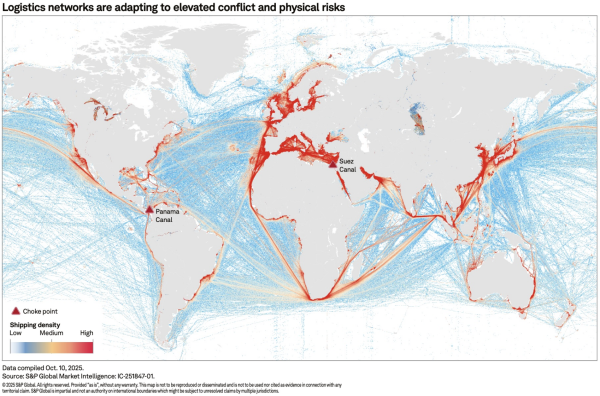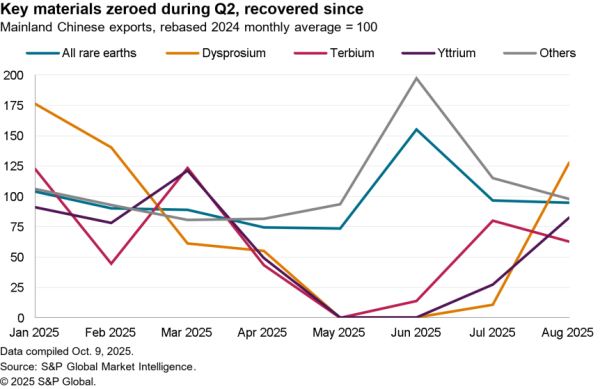Imports to the U.S. by volume grew by 5.1% year over year in September, continuing the logistics surge that has caused congestion in ports across the country. This was slower than in previous months but 17.4% higher than September 2019. The comparison to 2020 is now exceptional for a different reason — this time, it’s against a post-pandemic surge rather than lockdown-related lows. September also brings the growth rate for Q3 to 10.2% year over year, or 15.3% compared to Q3 2019.
There were an average of 95,341 TEUs per day in the quarter. If imports remain at the average Q3 level, Q4 would show a growth rate of 4.7% year over year, exceeding the record-breaking 2020 holiday season. Importers may be hoping that more surge capacity remains untapped, however, as increased imports would likely alleviate some of the pressures facing industries that rely on strong holiday sales.

Source: Panjiva
China regained the top growth spot in year-over-year comparisons, up 8.3%, higher than the import growth of other Asian countries. Imports from those Asian countries, excluding China, saw growth rates slow to 7.4% year over year in September, and import growth from Europe also slowed to 5.4%. Compared with 2019, China’s import growth rate climbed by 28.0%, while the growth rates of other Asian countries and Europe declined to 22.5% and 14.6%, respectively. Continued congestion may be at play here, while China may be enjoying a rebound in activity from the reopening of ports like Ningbo and Yantian.

Source: Panjiva
Dividing September’s imports by industry shows additional trends emerging. Industrials was the only industry that grew compared to both September 2020 and September 2019, up 4.3% and 19.4% respectively. The growth was driven by strong imports in the construction and agricultural sub-industries, growing 23.8% and 43.8% year over year respectively. Both of these may be benefiting from strong end-user demand, with high home prices driving construction and meat disruptions showing a need for additional investment in agriculture.
The consumer discretionary industry saw related imports fall by 0.3% year over year against the surge in 2020, but still increased by 22.2% against 2019. This likely reflects the congestion that importers are facing, which is stopping or slowing additional import growth at the aggregate level. The key growth drivers were the leisure (excluding toys), autos, and apparel industries, all of which reported an increase compared to both 2019 (27.7%, 21.3%, and 10.6% respectively) and 2020 (8.5%, 6.8%, and 7.8% respectively).
Imports of toys climbed 9.4% year over year but fell 1.7% versus 2019. The ability to increase from 2020 but not hit the full stride of previous years may be an indication that toy supply chains are still struggling with congestion and other disruptions. Household appliances, home furnishings, and consumer electronics all showed the opposite pattern, with imports down by 8.2%, 8.6% and 6.5% year over year respectively. While the logistics slowdown may have also hit these sectors, this may be an effect of strong lockdown and post lockdown demand for durables to make homes more comfortable for consumers.
Finally, the IT industry saw fewer imports in September compared to both 2019 and 2020, down 2.0% and 9.1%, respectively. Although the semiconductor subindustries reported growth — with semiconductors up by 84.8% year over year and semiconductor manufacturing equipment up by 64.7% — communications equipment fell by 21.3% year over year, while the hardware and components categories declined by 3.8% and 9.0% respectively. The semiconductor shortage is still the likely cause for this trend, with domestic manufacturing aggressively sourcing semiconductors for high-margin products while lower-margin electronics manufactured overseas see shortages.

Source: Panjiva
Just like industries have been affected differently by the year long peak season, ports have been hit differently as well. Comparing Panjiva’s U.S. imports dataset (including re-export shipments) by port in Q3 shows logjam congestion in the Ports of Los Angeles and Long Beach. This has made the news with imports through those terminals increasing by 10.8% year over year, 22.8% higher than Q3 2019. East coast ports like Newark/New York, Savannah, Houston, and Norfolk and Charleston have all also experienced large increases in activity, up 3.7%, 13.1%, 28.7%, 30.4%, and 25.0% year over year respectively, likely as importers look to avoid West Coast congestion by sourcing from Europe, or less frequently sending vessels the long way around the planet.
Surprisingly, the West Coast ports of Seattle/Tacoma and Oakland have not experienced a surge in activity as they are logical choices for vessels seeking to avoid congestion. The port of Oakland saw Q3 activity decrease by 4.5% year over year against 2020 and by 3.7% against 2019, Seattle/Tacoma saw volumes increase by 1.5% against 2020 and fall by 0.5% against 2019. This may expose a hidden factor in international trade, chiefly the critical role played by inland logistics networks including trucking, rail, and warehousing. It may not be an option to reroute vessels to other ports to alleviate the pressure on LA and Long Beach if the required inland services are not available at the scale needed to service an influx of volume. The ability of importers to quickly switch to other ports may also be an issue, many importers would have to find a new path for their goods, potentially increasing complaints to the carrier and possibly delaying delivery further than just waiting outside Southern California.

Source: Panjiva




